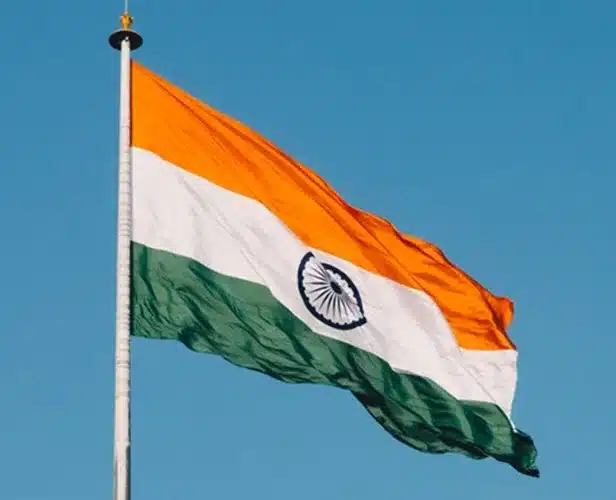The Republic of India gained its independence from the rule of the British on 15 August 1947. Since then, every year, 15th August is celebrated as Independence Day in India to commemorate its freedom from the 200-year-old British government. This year, India is observing Azadi Ka Amrit Mahotsav’ (India@75). Prime Minister of India, Shri Narendra Modi launched various other cultural and digital initiatives for the India@75 celebrations. On 15 August 2022, India will observe the 76th Independence Day celebration.
For India, 15 August is a day of her re-birth, a new start. At midnight on 15 August 1947, the British rulers handed the country back to its Indian leaders, ending a remarkable struggle that lasted for centuries. It was 15 August 1947, the historic date, on which sovereign India’s first Prime Minister Pandit Jawaharlal Nehru unfolded the tricolour flag of the nation on the glorious Red Fort. The day is significant in the history of India as bringing an end to the British colonial rule in India.
History of Independence Day
In 1757, after the British victory in the Battle of Plassey, the rule of the East India Company started in India. By 1858, the British Crown had assumed control over India. The situation after World War I was marked by suppressive and exploitative laws by the British. This led to revolutionary calls for independence and sparked the phase of non-violent and non-cooperation movements followed by the civil disobedience movement.
The enduring leader and a national symbol for all these movements was Mohandas Karamchand Gandhi- the Father of the Nation. The next decades were marked by constant struggles between the Indians and the British for freedom. Many movements and acts were carried out by the Indian National Congress, freedom fighters and the people of India.
In the year 1946, the Labour government, the exchequer of Britain thought of ending their rule over India because of their exhaustion of capital post World War II. The new viceroy, Lord Mountbatten, advanced the date for the transfer of power, believing the continuous contention between the Congress and the Muslim League might lead to a collapse of the interim government. He chose the second anniversary of Japan’s surrender in World War II, 15 August, as the date of power transfer. The British government announced on 3 June 1947 that it had accepted the idea of partitioning British India into two states; the successor governments would be given dominion status and would have an implicit right to secede from the British Commonwealth. The Indian Independence Act 1947 of the Parliament of the United Kingdom partitioned British India into the two new independent dominions of India and Pakistan with effect from 15 August 1947 and granted complete legislative authority to the respective constituent assemblies of the new countries. The Act received royal assent on 18 July 1947.
Celebrations in India
Every year, India’s Independence Day is celebrated on this day by all the proud Indians. 15th August is observed as a national holiday throughout the country. Though local governments conduct the ceremony of flag hoisting all over India, the venue of the main celebration is the Red Fort in the capital city New Delhi in India. The celebration starts every year with the unfurling of the tricoloured national flag by the Prime Minister of the nation, followed by a televised speech. The speech generally reflects the present condition of the nation along with the achievements in the previous year and the future development plans. A tribute is even paid by the Prime Minister to freedom fighters of India by declaring the day a national holiday. Post the flag-hoisting ceremony, patriotic programs by children from schools based in different states is one of the main attractions.
Independence and Partition Horrors Remembrance
As India gained independence from the brutal tyranny of the British, India suffered another harsh blow in form of separation. British India was divided into two independent Dominions: India and Pakistan. The two states have since been reorganized: the Dominion of India is now the Republic of India (since 1950), while the Dominion of Pakistan is now the Islamic Republic of Pakistan (since 1956) and the People’s Republic of Bangladesh (since 1971). As part of the partition, Bengal and Punjab were divided based on district-wide non-Muslim or Muslim majorities. As part of the partition, the British Indian Army, the Royal Indian Navy, the Indian Civil Service, the railways, and the central Treasury were divided. The partition was outlined in the Indian Independence Act 1947 and resulted in the dissolution of the British Raj, i.e. Crown rule in India. The two self-governing independent Dominions of India and Pakistan legally came into existence at midnight on 15 August 1947.
On 14 August 2021, Prime Minister Narendra Modi declared that the 14 of August annually will be remembered as Partition Horrors Remembrance Day to remind the nation of the sufferings and sacrifices of Indians during the partition in 1947. On 14 August 2021, Prime Minister Narendra Modi said,
Partitions pains can never be forgotten. Millions of our sisters and brothers were displaced and many lost their lives due to mindless hate and violence. In memory of the struggles and sacrifices of our people, 14th August will be observed as Partition Horrors Remembrance Day, May the Partition Horrors Remembrance Day keep reminding us of the need to remove the poison of social divisions, disharmony and further strengthen the spirit of oneness, social harmony and human empowerment.
Partition Horrors Remembrance Day is a yearly celebration on 14 August. It aims to remember the victims and sufferings of people during the Partition of India.

